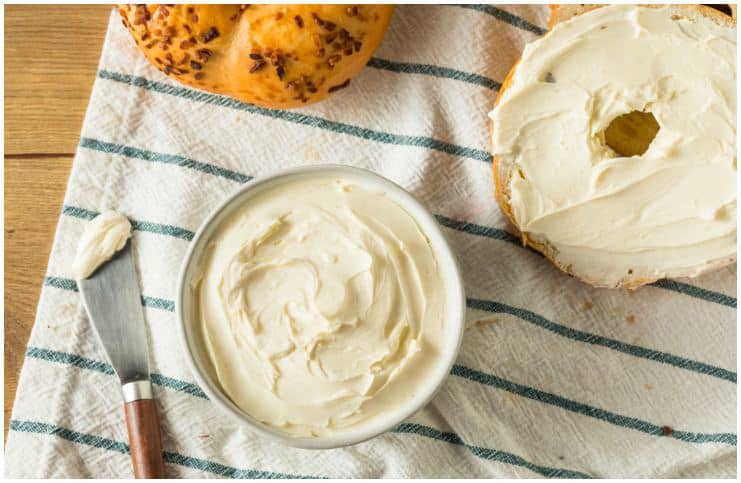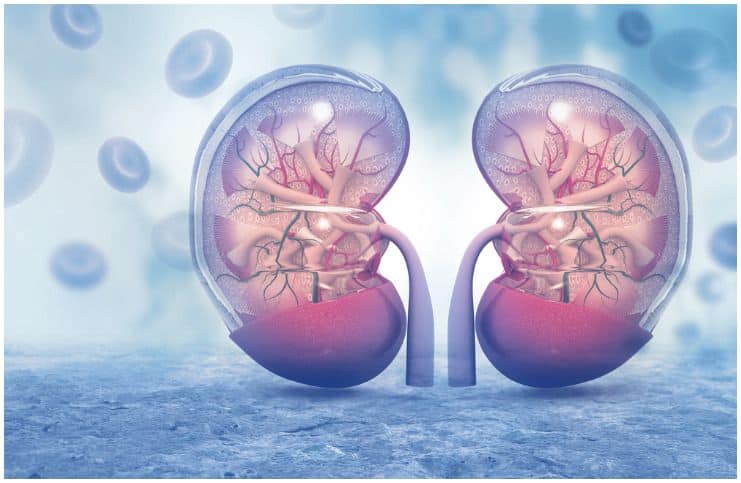This article reveals the differences between Neufchâtel cheese and cream cheese.
Neufchâtel Cheese
It is a traditional table cheese, which is originating from the village of Neufchâtel-en-Bray in northern Normandy. It was labeled AOC in 1977.
Neufchâtel is typically sold in heart shapes, however, it is also produced in other forms, such as boxes and logs.
It looks similar to Camembert (a moist, creamy, soft, surface-ripened cow’s milk cheese), with a white, dry, edible rind.
History
Its production is believed to date around the sixth century. The cheese is named after the village of Neufchâtel-en-Bray, which is located in Normandy, that literally translates as “heart of bray.”
According to tradition, during the wars during the Middle Ages between England and France, Norman girls (as a token of their affection) would give English soldiers a heart-shaped cheese.
The true Neufchatel cheeses make use of whole milk. Either raw or pasteurized milk can be used to produce this type of cheese.
There is also an American version of Neufchâtel cheese which:
- usually comes in a block shape;
- does not have a rind;
- is more like cream cheese than the French version;
- is pasteurized;
- uses cream and milk.
Note – the American version of Neufchâtel is the version you are most likely to see at the grocery store.
Nutrition Facts
100g of Neufchâtel cheese contains:
- 9.2g Protein – 18% daily value (DV);
- 253 calories;
- 22.8g Fat – 35%DV (from which 12.8g is Saturated Fat – 64%DV);
- 0g Fiber – 0% DV;
- 0mg Vitamin C – 0% DV;
- 0.4mg Vitamin E – 2% DV;
- 0.0mg Thiamin – 1% DV;
- 0.2mg Riboflavin – 9% DV;
- 0.2mg Niacin – 1% DV;
- 0.0mg Vitamin B6 – 2% DV;
- 14mcg Folate – 3% DV;
- 0.6mg Pantothenic Acid – 6% DV;
- 0.3mcg Vitamin B12 – 5%DV;
- 117mg Calcium – 12% DV;
- 0.1mg Iron – 1% DV;
- 10mg Magnesium – 2% DV;
- 138mg Phosphorus –14% DV;
- 152mg Potassium – 4% DV;
- 334mg Sodium – 14% DV;
- 0.8mg Zinc – 5% DV;
- 0 mg Manganese – 1%DV;
- 3mcg Selenium – 4% DV.
Taste
It has a grainy texture. Neufchâtel cheese has the taste and aroma of mushrooms.
Cream Cheese
It is a soft, mild-tasting fresh cheese that is made from cream and milk.
Regular cream cheese is usually sold in a bar form or in whipped tubs.
According to a 2015 survey, 3 of 4 American households consumed cream cheese in the last year.
It is not naturally matured and is meant to be consumed fresh.
Cream cheese lasts for around 10 days, possibly 14 days. Therefore, once the seal has been broken, it should be used as soon as possible.
The U.S. FDA defines cream cheese as containing at least 33 percent milkfat with a moisture content of not more than 55 percent.
History
Early types of cream cheese are mentioned in France as early as 1651 and England as early as 1583.
Officially, it was invented in 1872 by William Lawrence, an American dairyman from Chester, New York.
William Lawrence started Philadelphia Brand Cream Cheese in 1880.
In 1903, Lawrence sold his business to the Phoenix Cheese Company.
In 1928, Phoenix Cheese Company was acquired by the Kraft Cheese Company.
In 2015, Kraft Foods merged with Heinz, creating the 5th-largest food company worldwide.
Currently, Philadelphia Cream Cheese is extremely popular in the US, Europe, and in the United Kingdom. In Spain, cream cheese has the synonym of “Filadelfia.”
Nutrition Facts
100g of cream cheese contains:
- 5.9g Protein – 12% DV;
- 342 Calories;
- 34.2g Fat – 53%DV (from which 19.3g is Saturated Fat – 96%DV);
- 0g Fiber – 0% daily value;
- 0mg Vitamin C – 0% DV;
- 0.7mg Vitamin E – 3% DV;
- 0.0mg Thiamin – 1% DV;
- 0.1mg Riboflavin – 7% DV;
- 0.1mg Niacin – 1% DV;
- 0.0mg Vitamin B6 – 2% DV;
- 11mcg Folate – 3% DV;
- 0.6mg Pantothenic Acid – 6% DV;
- 0.3mcg Vitamin B12 – 4%DV;
- 98mg Calcium – 10% DV;
- 0.4mg Iron – 2% DV;
- 9mg Magnesium – 2% DV;
- 106mg Phosphorus –11% DV;
- 138mg Potassium – 4% DV;
- 321mg Sodium – 13% DV;
- 0.5mg Zinc – 3% DV;
- 0mg Manganese – 1%DV;
- 2.4mcg Selenium – 3% DV.
Taste
Cream cheese is comparable in texture and flavor to mascarpone cheese (an Italian cream cheese). Its consistency is thicker than butter, and it has a slightly salty and sour taste.
Side Effects
Both types of cheese are high in sodium (salt), saturated fats, and cholesterol.
Salt works on your kidneys to make your body hold on to more water. This puts extra strain on the insides of your arteries.
According to research, replacing foods that are high in saturated fat with healthier options can lower LDL (bad) cholesterol levels.
Additionally, eating too much fat can cause you to gain weight.
Note – according to the Centers for Disease Control and Prevention, obesity increases your risk of developing a range of serious health conditions.
The government recommends that:
- children should have less than 20g of saturated fat per day;
- women should not have more than 20g of saturated fat per day;
- men should not have more than 30g of saturated fat per day.
Bottom Line – Neufchâtel Cheese vs Cream Cheese
Neufchâtel is a mold-ripened cheese which is made in the Neufchâtel-en-Bray. It is usually matured for 8 to 10 weeks.
Cream cheese is usually made from a combination of pasteurized milk and cream. Also, some manufacturers may add stabilizing components to it, such as guar gum and carrageenans. It is a favorite product for creating savory dips for veggies or chips and topping crackers and bagels since it spreads easily at room temperature.
In conclusion, both types of cheeses are soft, white, and smooth textured and look very similar.
Regarding taste, Neufchâtel has the taste and the aroma of mushrooms, while cream cheese is a mild, sweet-tasting cheese and is commonly flavored with fruits, black pepper, garlic, and herbs.
Another difference is their place of origin. Cream cheese is an American invention that was developed in 1872 in NY, whereas Neufchâtel cheese is made in Neufchâtel-en-Bray in northern Normandy, France.
Additionally, according to the US FDA, Neufchâtel must be between 20-33% fat and <65% moisture, while cream cheese must be >33% fat and <55% moisture.
Carbs
There are very little carbs in both types of cheese, around 4 percent in both. But, there is one exception for creme cheese that can be flavored with fruits.
Regarding their nutritional profile, Neufchâtel has more protein and riboflavin and less fat and cholesterol, while cream cheese has more vitamin A. Therefore, Neufchâtel is healthier than cream cheese.
READ THIS NEXT:
Horned Melon (Kiwano): Health Benefits
References https://www.statista.com/statistics/278972/us-households-usage https://swirled.com/cream-cheese-facts/ https://www.bonappetit.com/recipes/slideshow/cream-


